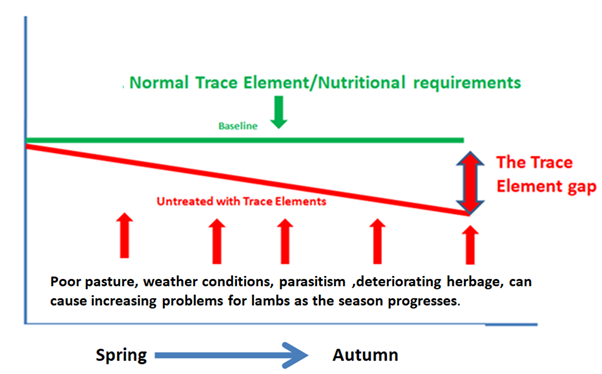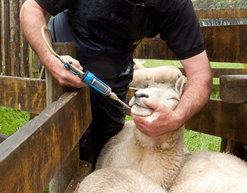Written by Dr T.B Barragry PhD,MSc,MVB,MRCVS
Physiologically, lambs are precision instruments and can be prone to a great number of health and productivity problems while on pasture. Adequacy of nutrient intake by the young lamb can be hit and miss in many cases, depending on weather conditions, soil type, parasitism, pasture quality and herbage type.
It is therefore not surprising that many lambs on pasture succumb to borderline trace element and vitamin deficiencies, which may or may not be obvious to the farmer. Although outward clinical signs may be minimal, the result of such deficiencies lies in the extra length of time the lamb takes to gain bodyweight and, it’s susceptibility to other diseases. Diagnosis can be difficult as clinical signs are frequently mild, nonspecific, and insidious in onset, such as poor growth rates, weak lambs, ill thrift, or reduced feed intake. Problems tend to affect the whole group rather than individual animals.
Maintenance of a stable trace element status can be a challenge in many sheep flocks. During the season, many sheep are exposed to poor quality grazing and forage which possesses quite low trace element and nutritional values. Lambs are also subjected to the stresses of harsh outdoor conditions and exposed on hillsides to extreme weather variations. Occasional foot problems in lambs can significantly impede mobility and grazing and lead to inadequate nutritional intake. Soil and herbage composition can vary in different geographical areas and can determine the various specific trace element deficiencies that are found in local regions. As the season progresses, the decreasing quality and availability of herbage increase the risk of problems occurring.

All these factors acting together can contribute to borderline deficiencies of selenium, vitamin E, vitamin B12, copper, cobalt, zinc, and iodine in sheep.
Trace element shortages all negatively impact on the general health of the lamb and also lower its immunity status. This low immunity can predispose to parasitic infestation. In lamb flocks, there is considerable interaction between chronic parasitism and trace element deficiency states such that it may prove difficult to ascertain which came first. Hence lambs are particularly susceptible to parasitic diseases such as Parasitic Gastro Enteritis (PGE), Haemonchus, Liver Fluke and Nematodirus all of which can absorb vital minerals and vitamins from the bloodstream, and thus reduce the nutritional baseline of the animal even further. The most common trace element deficiencies in sheep include Copper, Cobalt, Selenium/Vitamin E and to a lesser extent Iodine and Manganese.
Copper
Copper is an essential component of several important enzymes and metabolic functioning in the body. Deficiency occurs either due to low copper intakes from grazing or more commonly, excess intakes of copper antagonists (iron, molybdenum & sulphur) which block dietary copper uptake, making it unavailable to the animal. Copper deficiency can occur when sheep graze pastures low in copper but more often it occurs in pastures high in iron, molybdenum, and sulphur. Where two or more of these elements exist together on a farm, in quite ‘normal’ concentrations, they will act to bind out copper from a diet. Swayback is the most common sign of deficiency, but often poor fertility, poor quality wool, and growth can be attributed to copper deficiency
The most readily recognisable clinical sign of copper deficiency in sheep is the development of ‘Swayback’ in young lambs; This is a progressive hind limb weakness leading to paralysis due to damage to the spinal cord during foetal development mid-pregnancy in copper deficient ewes. Copper deficiency in older animals has been linked to poor fleece quality, reduced growth rates, anaemia, and increased susceptibility to bacterial infections. Copper supplementation will be necessary in these animals bearing in mind that sheep are susceptible to copper poisoning.

Cobalt
Cobalt is an essential precursor of vitamin B12 and is synthesised by the rumen micro-organisms. Vitamin B12 and cobalt are required for cell replication and for blood cell turnover. The symptoms commonly associated with cobalt deficiency manifest themselves as a result of a lack of vitamin B12 in the animal, rather than of cobalt. Clinical signs of cobalt deficiency are usually observed in weaned lambs at pasture during summer and autumn. Signs include lethargy, reduced appetite, poor quality wool with an open fleece, small size and poor body condition despite adequate nutrition.

Cobalt deficiency (‘Pine’) in autumn results in ill-thrift, lethargy, poor appetite, watery ocular discharge, and poor fleece quality. As a consequence of this deficiency lambs have poor immune function and are often more prone to infectious disease (e.g., clostridia, Pasteurella). Parasitic disease will exacerbate clinical signs by reducing gut vitamin B12 absorption, sometimes resulting in symptoms of deficiency even when nutrition and dietary cobalt levels appear to be adequate.
Selenium / Vitamin E
Selenium and Vitamin E act synergistically as protective antioxidants within the body and act to support immune function and antibody formation. However, selenium deficiency occurs in soils of certain geographic areas and can lead to pasture/crop deficiency
A primary clinical sign of selenium deficiency is ‘white muscle disease,’ although disease prevalence is low. Usually, rapidly growing lambs are affected, with sudden onset generalised stiffness, which may progress to an inability to stand within a few days if left untreated. In older growing animals’ selenium deficiency has been linked to poor daily live weight gain and in breeding ewes can cause embryonic death and poor fertility performance.
Iodine & Manganese
Iodine is a component of the thyroid hormone thyroxine (T4) which controls energy metabolism, growth, and general metabolism. Iodine is therefore central to a good feed conversion ratio and weight gain. The utilisation of iodine in the body also depends on selenium, as selenium is a co factor in the synthesis of thyroid hormone Deficiency is typically associated with an enlarged thyroid (goitre), stunting of growth and results in late abortions, stillbirth and/or increased lamb mortality. Some soils may be iodine deficient (primary deficiency) whereas brassica species such, root crops, rape and kale contain goitrogens which block the uptake of iodine (secondary deficiency).
Manganese is essential to several enzyme systems. Deficiency is rare; however, symptoms such as joint or bone abnormalities and a stiff gait are reported, along with potential negative effects on fertility due to poor oestrus expression and conception rates.
Some Vitamins
Vitamins are important for making sure that all the body’s cells are functioning properly, and B vitamins can act as co factors for trace element enzymes. B Vitamins help the body convert food into energy (metabolism), energy into fat and protein, create new blood cells, and maintain healthy skin cells, brain cells, and other body tissues. There are eight types of primary B vitamins, each with their own function.
Folic acid is especially important as a co factor in DNA synthesis and for cell replication and rapid cell turnover. This is vital for blood cell and gut cell formation. Folate acts together with vitamin B12 in this regard by regulating cell division and DNA turnover.
Vitamin A (and beta carotene) are required by lambs for a variety of functions throughout multiple body systems. Plants produce carotene, which the ruminant then converts in the intestine into vitamin A. The greenness of the plant is a relatively good indicator of the carotene content. Vitamin A, together with zinc, directly affects immunity, through both production of antibodies and through maintaining an adequate barrier to infection with healthy skin cells. Vitamin A deficiency not only compromises the integrity of the mucous membranes and skin that serve as first-line defence barriers, but also reduces the primary antibody response in the event of infection. Vitamin E (and Vitamin C Ascorbic acid) is a potent antioxidant, immunostimulant and counteracts oxidative stress.
Trace Element & Vitamin Drenches.
Oral drenching is usually less expensive than boluses, and it also allows for targeting of delivery to certain animals or at specific stress periods during the grazing season or winter housing where only short-term cover is needed. It may also be more cost effective in the long term insofar as it targets delivery to the most susceptible animals.

Drenches also have an advantage that
- A larger number of trace elements can be included
- Vitamins can be incorporated into the formulation also (Vitamins E ,A,C ,D, B) which can act to potentiate some of the actions of the trace elements and thus boost overall effectiveness in the short term
- High concentrations to address the deficiency can be included